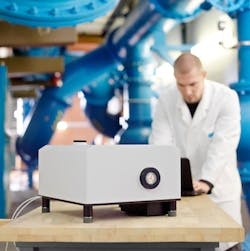QCL-based spectrometer offers an automated way to quickly test drinking water

Freiburg, Germany--Researchers from the Fraunhofer Institute for Applied Solid State Physics IAF have developed a quantum-cascade-laser (QCL)-based analysis apparatus that allows drinking water to be sampled automatically at the waterworks itself. As a result, water companies can determine within a few minutes whether their water contains any impurities, and what those impurities are. The system was designed to enable immediate identification of dangerous substances. "The equipment samples the water for dangerous substances at the waterworks itself in the course of routine operations, and allows for a rapid response," says Frank Fuchs, Fraunhofer IAF coordinator for the IRLSENS project, which is funded by Germany's Federal Ministry of Education and Research (BMBF). "The main sticking point is the intensity of the light. In order to be in a position to employ molecular spectroscopy at the waterworks itself, we needed to find a more powerful light source."
Fraunhofer IAF's QCL produces light that is up to 1000 times more spectrally bright than the silicon carbide (SiC) thermal emitters used in the laboratory to date (for molecular spectroscopy, analysts are interested in wavelengths between 7.3 and 11 micrometers). The measurement system is a little larger than a shoebox, works automatically, and requires little maintenance.
A demonstrator has already successfully undergone initial practical testing. At the Kleine Kinzig waterworks in the Black Forest, tests were conducted on various concentrations of sweetener as a simulant substance. Measurements were taken every three minutes over a period of six weeks, with the fully automated system collecting a total of 21,000 samples. The result: every sample was recorded in perfect detail without a single error. Even the concerns regarding the susceptibility of the laser spectrometer to vibrations were proved unfounded, since the machines and pumps in operation in the machine hall had no adverse impact on the test results. Providing there is sufficient demand, project partner Bruker Optik, the company that built the demonstrator, would like to develop the measurement system into a finished product.

John Wallace | Senior Technical Editor (1998-2022)
John Wallace was with Laser Focus World for nearly 25 years, retiring in late June 2022. He obtained a bachelor's degree in mechanical engineering and physics at Rutgers University and a master's in optical engineering at the University of Rochester. Before becoming an editor, John worked as an engineer at RCA, Exxon, Eastman Kodak, and GCA Corporation.